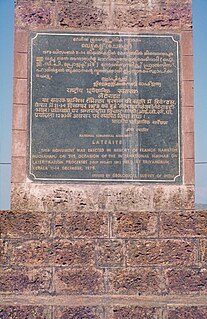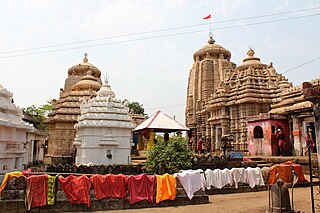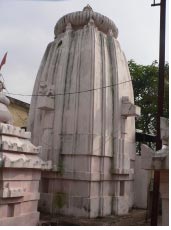Physical description
Surrounding: The Rest house is surrounded by another rest house in west at a distance of 1.35 metres, compound wall on east at a distance of 4.00 metres, Arjunesvara temple on north within a distance of 1.85 metres and a modern structure in south at a distance of 1.50 metres.
Orientation: The Rest house is facing towards north.
Architectural features (Plan & Elevation)
On plan, the structure has a square vimana measuring 4.00 square metres, with a frontal porch measuring 2.00 metres in length. On elevation, the vimana is in pidha order that measures 5.03 metres in height from pabhaga to mastaka. From bottom to the top the temple has a bada, gandi and mastaka. With fivefold divisions of the bada the temple has a panchanga bada measuring 2.53 metres in height. Pabhaga measures 0.49 metres, tala jangha 0.62 metres, bandhana 0.23 metres, upara jangha 0.61 metres 42 and baranda 0.59 metres. The gandi measures 2.00 metres and mastaka 0.50 metres.
Raha niche & Parsvadevatas
No raha niche or parsvadevatas on the temple walls.
Decorative features
- Door Jambs: There are two door ways leading into the sanctum
- Lintel: Lintel is plain
- Building material: Laterite
- Construction techniques: Ashlar masonry with lime and cement mortar.
- Style: Kalingan

Laterite is a soil and rock type rich in iron and aluminium and is commonly considered to have formed in hot and wet tropical areas. Nearly all laterites are of rusty-red coloration, because of high iron oxide content. They develop by intensive and prolonged weathering of the underlying parent rock. Tropical weathering (laterization) is a prolonged process of chemical weathering which produces a wide variety in the thickness, grade, chemistry and ore mineralogy of the resulting soils. The majority of the land area containing laterites is between the tropics of Cancer and Capricorn.

Lime is a calcium-containing inorganic mineral composed primarily of oxides, and hydroxide, usually calcium oxide and/ or calcium hydroxide. It is also the name for calcium oxide which occurs as a product of coal seam fires and in altered limestone xenoliths in volcanic ejecta. The word lime originates with its earliest use as building mortar and has the sense of sticking or adhering.

Kedareswar Temple, one of the eight Astasambhu Temples, is near the Mukteswar Temple, in Bhubaneswar, Orissa. The presiding deity is Lord Shiva, referred to locally by the name ‘Kedareshwar’. It is in the precinct of Kedara-Gouri on the right side of the road leading to Puri from Bhubaneswar and at a distance of 40 metres south of Muktesvara. It is one of the ten monuments within the precinct. It is the main temple of the complex. The temple is facing south and the enshrined deity is a circular yonipitha made of sandstone. The linga at the centre is missing. The sanctum is 2.5 square meters which is 0.8 meters below the present ground. It stands near the yard of the Mukteswar Temple.

Kalabhairavi Temple is located within the Jaleswar Siva Temple Precinct, Kalarahanga. The enshrined deity is a four armed Chamunda sitting over a dead body. The deity holds a khatuanga in her upper right hand, a snake in upper left hand, a severed head in lower left hand and the lower right hand is broken. The deity is crowned with jatamukuta and wearing a garland of skull. The whole image rests over a pedestal measuring 0.50 metres in height.

Kalikadevi Temple is located in the Kancha Sahi, Old Town, Bhubaneswar. It is on the right side of the Temple road leading from Lingaraja Temple to Garej chowk. The enshrined deity is a four armed female divinity locally known as Kali.

The Kapilesvara Siva temple is a Hindu temple dedicated to Lord Siva located in the south western outskirt of the village Kapilesvara, Old Town, Bhubaneswar, Orissa, India. It is located at the end of Kapilesvara road leading from Lingaraj temple to Kapilesvara Village. The presiding deity is a Siva-lingam at the center of a circular yonipitha inside the sanctum. It is a living temple, facing towards east and maintained by Kapilesvara Temple Trust Board. The temple is situated within the precinct along with 33 other monuments. The precinct is located on the northern embankment of Manikarnika tank over an area of 44.00 square metres.

Champakesvara Siva Temple is located Ambika Sahi in the Old Town area of Bhubaneswar. It is 157 metres west of Parasuramesvara on the right side of the Kotitirthesvara lane leading to Bindu sagara. It is a laterite temple. Local people believe that the enshrined Siva lingam is patalaphuta and the precinct is the abode of nagas(champa naga) after whom the deity is named as Champakesvara. The local people also believe that the temple precinct which is a den for the snakes do not harm any body.

Chintamaniswar Siva Temple is a Hindu temple dedicated to Lord Siva in Bhubaneswar, the capital of Orissa, India. It is at the end of the Chintamaniswar road branching from Cuttack-Puri road near the Old Station Bazar. The temple faces west and the enshrined deity is a Siva lingam with a yonipitha.

Patalesvara Siva Temple – I is a temple dedicated to Lord Shiva, located in Old Town, Bhubaneswar. This temple dates back to 13th century, and belongs to the Ganga era. At present, this temple is situated inside the compound wall of a private residence.

Purvesvara Siva Temple is located in Kancha Sahi, in the Old Town of Bhubaneswar. It was built in 13th century AD. It is a living temple and now under the care of Purvesvara Temple Development Association.

Svapnesvara Siva temple is in Gourinagar, Old Town, Bhubaneswar, the capital of Orissa. It is 200 m northeast of Purvesvara Siva temple. The temple is facing east. The 2 m2 sanctum is empty.
The Hanuman Temple is located in the Kedara-Gouri temple precinct, Kedara-Gouri road, Old Town, Bhubaneswar. The enshrined deity is a two-armed Hanuman image. This temple is maintained by the Kedara-Gouri Trust Board. Architectural features indicate that the temple was built in the 15th or 16th century A.D. It is constructed in kalingan style with laterite stone.

Markandesvara Siva Temple was constructed by Kesaris to commemorate the visit of sage Markandeya. Same as the Samesvara Siva temple. It is an abandoned temple and is facing towards the east. However at the center of the sanctum there is a Siva-lingam with the circular Yoni pitha. The temple is totally covered with wild vegetations.

Nilakantha Siva temple is located in the Kharakhia Baidyanatha temple precinct, Kharakhia Vaidyanath Sahi, Old Town, Bhubaneswar. One can approach to this site on the left side of the Vaidyanath road leading from Lingaraja temple to Kapilesvara. This is a living temple and is facing towards the west. The enshrining deity of this temple is a Siva lingam within a circular yoni pitha at the centre of the sanctum sanatorium. The sanctum is 0.77 metres below the chandrasila.

The Somesvara Siva temple is located in the Kharakhia Baidyanath temple precinct in Kharakhia Vaidyanath Sahi, Old Town, of Bhubaneswar. It is located approximately 300 metres south of Lingaraja temple. Visitors may approach the site on the left side of Baidyanath Road leading from Lingaraja temple to Kapilesvar. It is a living temple and faces towards the west. The enshrined deity of this temple is a Siva lingam within a circular yonipitha at the center of the sanctuary located 0.93 metres below the chandrasila. The temple is under the care and maintenance of Babulal Makaddam Badu Mohapatra, the chief priest of the temple, on whose private land the temple stands.

Isanesvara Siva Temple is a 13th-century ad temple in Bhubaneswar in the state of Orissa, India. The time period of its construction is estimated from its architectural features and it is suggests the temple to ganga period. Isanesvara Siva temple is situated in the Goasagaresvartemple precinct. It is located on the left side of Ratha road old Town, Bhubaneswar. It is located at a distance of 1 km west of Lingaraja Temple and 1 km south of Ananta Vasudev, 300 metres south west of Ramesvara temple and 200 metres north west of Baitala Deula. The temple is facing towards east. The presiding deity is only a circular yon pitha. The lingam is missing.

The Tirthesvara Siva temple is a Hindu template located in Bhubaneswar, the capital of Orissa, India.

Lakhesvara Siva temple Location: Lat 20° 14’ 33"N, Long 85° 50’ 17" E, Elev 60 ft. Approach- Lakhesvara Siva temple is located in the right side of the Ganges–Yamuna road, behind the Lingaraja market complex, Old town, Bhubaneswar. It is situated at a distance of 70 metres north east of Lingaraj temple and at a distance of 10 metres south of Gangesvara and Yamunesvara Siva temple across the road. The temple is facing towards the east. The enshrining deity is a Siva lingam within a circular yoni-pitha, which is 0.77 metres below the chandrasila.

Mangalesvara Siva Temple is a Hindu temple located in Bhubaneswar, Orissa, India. It is located at Lat- 20◦ 14’ 38" N., Long- 85◦ 50’ 38" E., and at an elevation of 45 ft.

1. Name:

Devasabha Temple is located in the Kharakhia Vaidyanath temple precinct, Old Town area of Bhubaneswar. This is an abandoned temple and is facing towards the east. There is no deity inside the cella. As per the locals, the temple is the assembly of all gods and goddess for which it is known as Devasabha.

Suka Temple is abandoned and not in use. The temple is devoted to saptaratha and the presence of female counterparts of the dikpalas in the upara jangha. This was built in the matured phase of temple building tradition of Orissa.

















